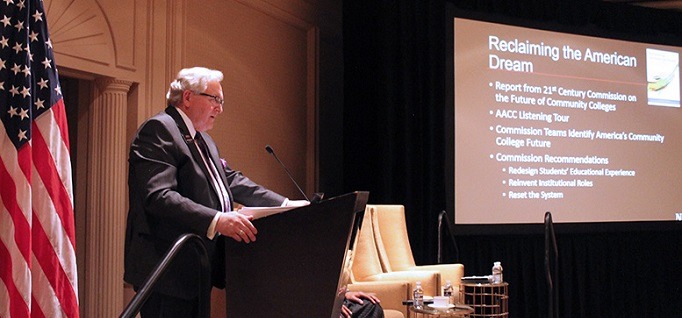Using the ‘Blue Book’ as a guide
By Matthew Dembicki
November 22, 2017
A Nebraska college has spent the past four years redesigning, reinventing and resetting processes to improve student success.
Michael Chipps, president of Nebraska’s Northeast Community College, says his college has spent the past four years redesigning, reinventing and resetting processes, people and practices by using the “Blue Book” as a foundational guide.
That “Blue Book” is the American Association of Community Colleges’ (AACC) 2014 report “Empowering Community Colleges to Build the Nation’s Workforce: An Implementation Guide,” which serves as a guide to drive the recommendations of AACC’s 21st-Century Commission in transforming community colleges to dramatically improve college completion.
“Northeast has used the Blue Book as the solid foundation on which to build our comprehensive strategic plan called Vision 2020,” Chipps said at the opening session of the AACC Fall Meeting in Arlington, Virginia.
Like for many other community colleges, Northeast’s review started by looking at its mission statement, which hadn’t been revised since 1995. It now reads: “Northeast Nebraska Community College is dedicated to the success of students and the region it serves.”
Rolling up the sleeves
The four goals crafted for Vision 2020 were fairly straightforward but important, Chipps said: increase student success; increase student access; provide a globally competitive workforce; and maximize resources. Then came the tough part: how to accomplish those goals. That step took much trial and error, but after about four years — and much input from faculty and other stakeholders — Northeast set 63 “action items.” The college drafts a monthly report tracking progress on these items.
Next, the college took the Blue Book’s seven recommendations and integrated them into Vision 2020 and operationalized them. For example, for the recommendation to increase completion rates by 50 percent by 2020, the college aimed to ensure that all employees’ goals were focused on student success completion, and those goals have been formalized and are part of the annual performance review.
“Each employee’s goals are to represent elements of student success, student completion and growing enrollment,” Chipps said.
Northeast also focused on creating a culture of student success through transforming its advising by assigning a professional advisor to all new degree-seeking students. Faculty become secondary advisors when students enter their second year.
As a result of these and other changes, completion rates at Northeast increased from 46 percent in 2015 to 53 percent in 2017 for first-time, full-time, degree-seeking students.
For another Blue Book recommendation — implementing practices and policies that promote rigor and accountability — Northeast focused on collaborating across divisions, requiring student orientation, implementing FAME (family, academics, motivation and economics) and expanding work-based learning.
The FAME score, for example, helps the college identify students who may have obstacles to success and allows staff to begin interventions early.
“We can help students better if we know what they’re coming to us with,” Chipps said.
There’s more to the story. Read the full article in CC Daily.



